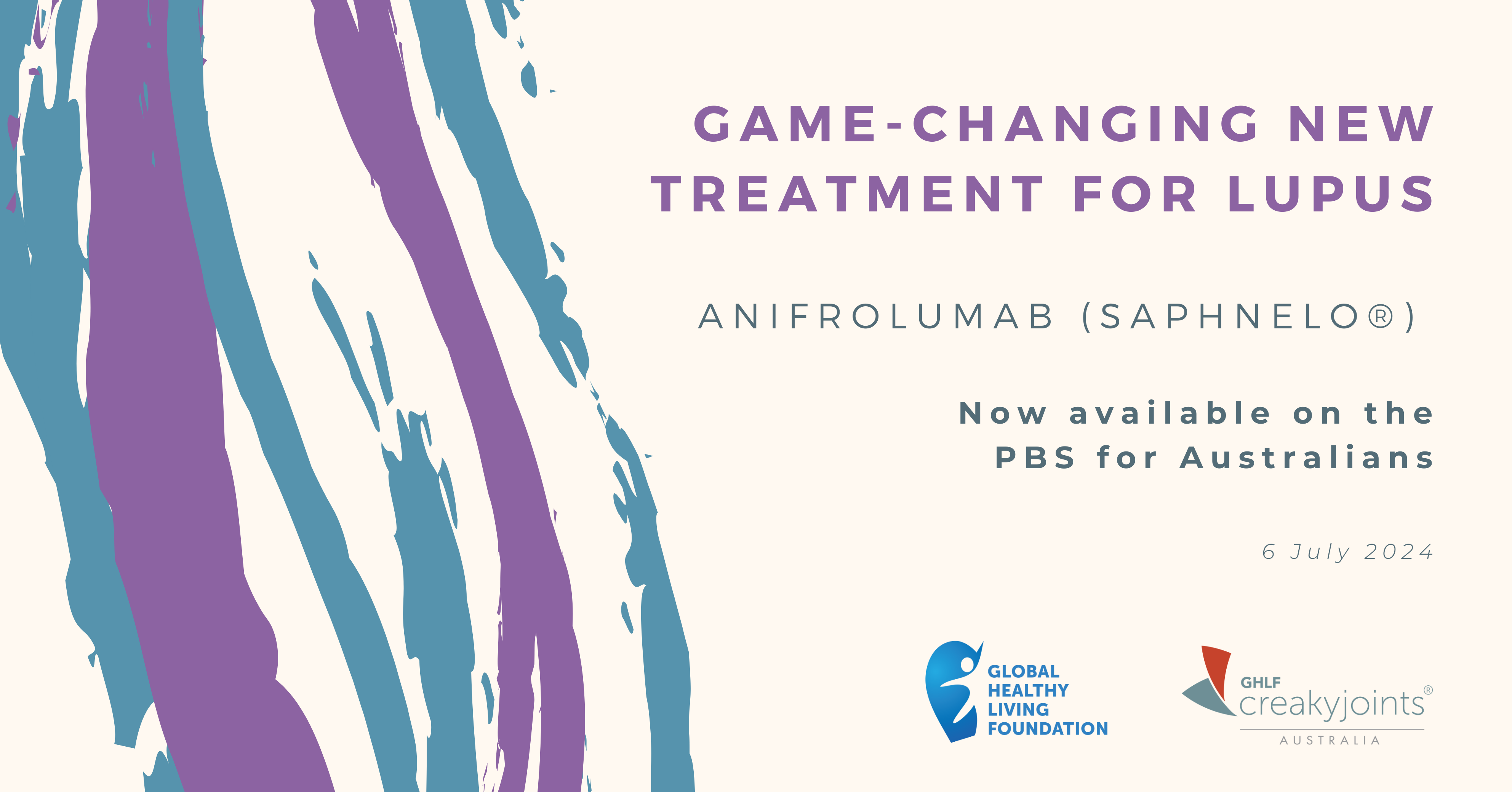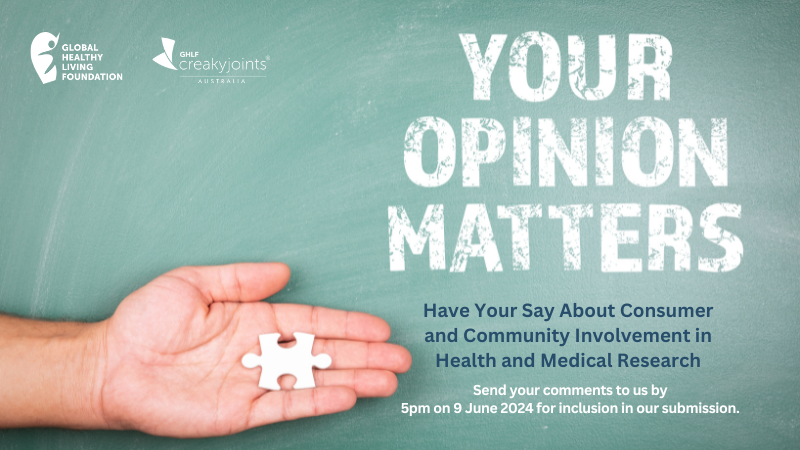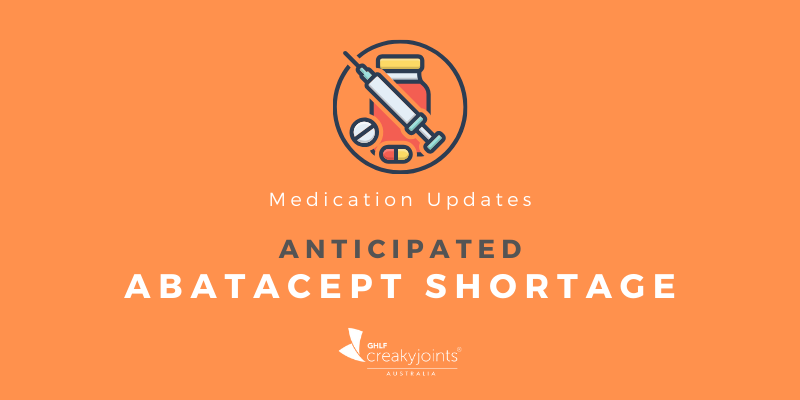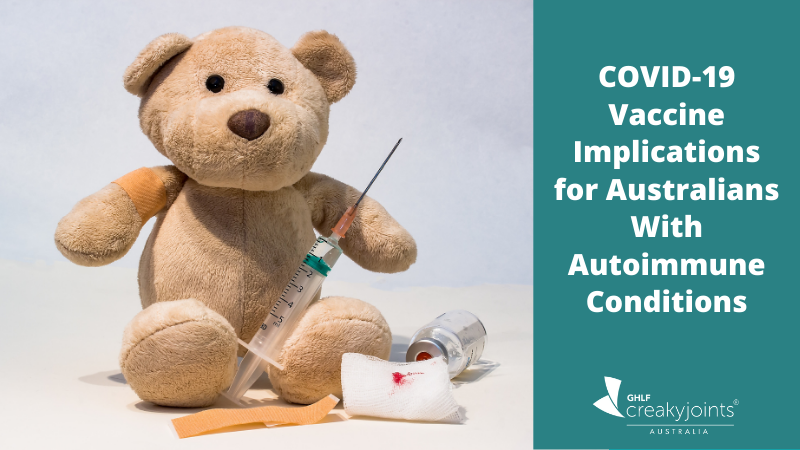

11 January 2021
On this page:
- The Balance Between Immunosuppressants and Vaccines
- Types of COVID-19 Vaccines and How They Work
- Can Immunocompromised People Have COVID-19 Vaccines?
- Which COVID-19 Vaccines Will Australia Get?
- Other Types of COVID-19 Vaccines
- A Potential Vaccine Alternative for Immunocompromised People
- Australia Has Time on its Side
- The COVID-19 Vaccine National Rollout Strategy
- COVID-19 Vaccine Distribution Phases
With the global push to get effective COVID-19 vaccines approved and distributed quickly, many people have been debating whether or not they want to get vaccinated. However, for people with autoimmune health issues, the big question is more like “Can I receive the vaccination in the first place?”
Autoimmune conditions can be triggered when the immune system overreacts to specific pathogens that have entered the body (such as viral or bacterial infections) and starts to attack our healthy cells as well. Different types of autoimmune conditions affect the body in different ways. For example, autoimmune arthritis (such as rheumatoid arthritis and ankylosing spondylitis) affects the joints, type 1 diabetes affects the pancreas, systemic lupus erythematosus affects connective tissue throughout the body and multiple sclerosis affects the nervous system.
The Balance Between Immunosuppressants and Vaccines
Many people with autoimmune conditions need medications to suppress their immune system response (known as immunosuppressants). However, this process can also allow some pathogens to get past the ‘gatekeeper’ (the immune system) and start spreading infection unchecked. The main medications used to suppress the immune system for people with autoimmune arthritis are known as disease-modifying anti-rheumatic drugs (DMARDs). Those with more severe forms of these conditions often take advanced DMARDs (biologic DMARDs or JAK inhibitors) which are more effective against the disease but also increase infection risks.
Working out what types and doses of vaccine those with autoimmune conditions can safely and effectively receive is a precise art that requires detailed study plus a bit of guesswork, as each of our situations is different.
Types of COVID-19 Vaccines and How They Work
Vaccines are complex biological substances specifically designed to induce a protective, safe and effective immune response in humans (and animals). Vaccines work by inducing the immune system to create antibodies that bind to and block intruding pathogenic organisms (germs) or their toxins, therefore preventing their spread within the body.
According to the World Health Organisation, as of 10 December 2020, there were over 50 potential COVID-19 vaccine candidates in clinical trials around the world and around another 160 in preclinical evaluation. A handful have already been given provisional approval to be rolled out in some overseas countries in an attempt to curb the rapid spread of the virus in those regions.
Almost all of the vaccines in development globally require two doses delivered a few weeks apart. The second dose is crucial to ensure maximum effectiveness.
All the COVID-19 vaccines currently in development or being rolled out work by reducing disease severity but there has been little evidence to show that they prevent transmission of the virus. Therefore, even if you have both doses of a COVID-19 vaccine, it is likely that you can still spread the virus to others. Governments and health organisations across the world will be monitoring this data very closely over the coming years. In the meantime, it is vital that we all continue to use COVID-safe practices in our daily lives.
Can Immunocompromised People Have COVID-19 Vaccines?
It is too soon to tell how effective any of the current vaccine candidates will be for people with compromised immune systems as this cohort was not included in the Phase 3 clinical trials that led to the authorisation for the COVID-19 vaccines that have recently been released for emergency use in other countries.
There is currently no evidence to suggest that any of the major candidates will have any long-term safety issues and all vaccines used in Australia will still need to follow the normal and complete approval process used by the Therapeutic Goods Administration (TGA) for all vaccines.
Clinical trials are usually only conducted on healthy people first as existing health issues may influence the trial results. However, that does not mean that immunocompromised people won’t be able to have the COVID-19 vaccines listed above when they become available in Australia. We can have them, it just means that they may be less effective and we will need to watch out for any potential side-effects (just like everyone else who receives the vaccine).
In general terms, a vaccine that protects us from severe disease to some extent is still better than not having a vaccine at all. As more people are vaccinated, more data will be available for researchers to track.
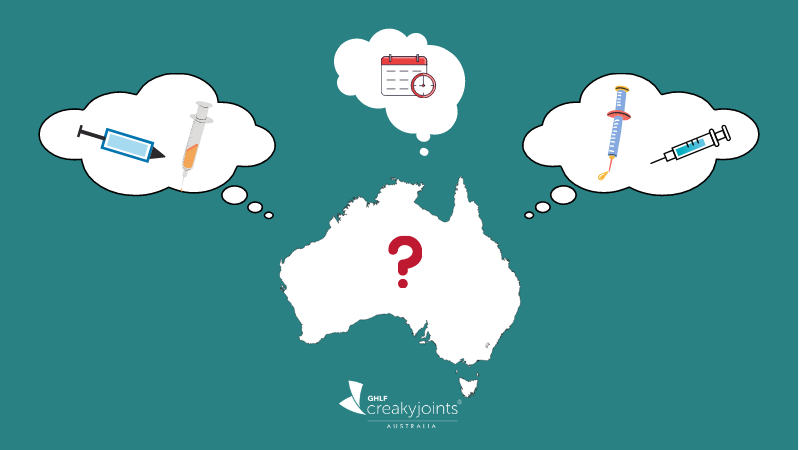

Which COVID-19 Vaccines Will Australia Get?
The Australian Government currently has arrangements in place for three promising vaccines to be rolled out in stages from February 2021 once they have been approved by the TGA. Clinical trials on a fourth vaccine, the University of Queensland/CSL vaccine, were abandoned in late 2020 after multiple participants returned false-positive HIV test results.
It is not unusual for trials to be cancelled. Many vaccine and drug candidates for various conditions have failed to complete the clinical trial process over the years. This is not a bad thing and shows that the procedures followed in clinical trials have successfully prevented unsafe or ineffective candidates being released. Sometimes, the candidate sponsors (the pharmaceutical companies) use the information learned from an abandoned trial to design a new candidate that goes on to be released.
The three vaccine candidates that the Australian Government has already agreed to purchase (subject to approval by the TGA) are the:
- Pfizer/BioNTech vaccine
- Oxford University/AstraZeneca vaccine
- Novavax vaccine
Pfizer/BioNTech vaccine
This messenger RNA (mRNA) vaccine is a new type of vaccine. Messenger RNA is the molecule that gives instructions to the DNA in our cells. The vaccine works by injecting synthetically-produced mRNA “pre-programmed” with specific instructions into the cells (rather than injecting the virus itself). The cells then follow the instructions to begin producing viral proteins. These proteins do not join up to form a virus but the body will still develop a defensive response to the virus.
mRNA is very fragile and cannot be injected directly into the body, so it is surrounded by a layer of fat particles in the vaccine. It’s this “lipid layer” that requires the Pfizer vaccine to be frozen using dry ice at temperatures around -70°C. Custom-made storage will be used to transport the frozen vials in batches straight to the designated vaccine locations as needed. Australia will import all of these Pfizer mRNA vaccines as we do not have the capacity to manufacture them here.
Oxford University/AstraZeneca vaccine
This is a viral vector vaccine. It is also a new type of vaccine and is created by inserting genetic material from the COVID-19 coronavirus (SARS-CoV-2) into a harmless virus (similar to the common cold) and injecting this mix into the body. Once the viral vector vaccine is released into human cells the cells form proteins unique to the coronavirus. This enables the body to start building an immune response without causing symptoms. If the person does become infected with the real virus, their immune system will remember how to respond appropriately to fight it.
The initial batches of the Oxford AZ vaccine will be imported, however, the majority of the batches needed for the Australian population will be made here.
Novavax vaccine
This is a protein subunit vaccine which is a more conventional type of vaccine that uses harmless genetic parts or “subunits” of viral proteins (in this case, coronavirus SARS-CoV-2). Once injected, the immune system will register that they are “foreign invaders” and will mount an immune response to them. The Novavax vaccine will be fully imported.
Other examples of this type of vaccine include:
- Meningococcal disease
- Hepatitis B
- HPV (Human papillomavirus)
- Whooping cough
The Oxford AZ and the Novavax vaccines only require standard refrigeration (just like vaccines for other conditions) so they will likely be more appropriate than the Pfizer vaccine for distribution in remote areas of Australia.
Along with these three pre-purchase agreements, the Australian Government is also part of the global COVAX initiative. This gives us the option to access other leading COVID-19 vaccine candidates and supports equitable access to safe and effective vaccines for all participating countries.
The Australian Government’s decisions will be guided by advice from the Australian Technical Advisory Group on Immunisation (ATAGI) over the coming months.
Other Types of COVID-19 Vaccines
Other types of COVID-19 vaccines currently in development around the world include live-attenuated and inactivated vaccines.
Live-attenuated vaccines
These are a weakened (but still active) version of the virus that causes a specific disease. As they are similar to the virus they aim to control, they generate a strong immune response that can last a lifetime.
Live vaccines are generally not recommended for anyone with a compromised immune system as their immune response may be too severe and risky. (However, they may be used in individual circumstances.)
Examples of live vaccines include:
- MMR (measles, mumps, rubella)
- Varicella zoster (Chicken Pox)
- Herpes zoster (Shingles)
Inactivated vaccines
A “killed” version of the germ that causes a specific disease. These are not as potent as “live” vaccines, so more doses may be needed to make them as effective. They can normally be used by immunocompromised people.
Examples of inactivated vaccines Include:
- Hepatitis A
- Flu (shot only)
- Polio (shot only)
A Potential Vaccine Alternative for Immunocompromised People
In promising news, AstraZeneca has started a Phase III trial (called PROVENT) focusing on the safety and effectiveness of a long-acting monoclonal antibody (LAAB) combination called AZD7442. This trial is being conducted across Europe and in the US. Its purpose is to evaluate whether this experimental combination is effective at preventing COVID-19 in at-risk groups, such as the immunocompromised, for up to 12 months.
It is believed that this combination will be “almost like a passive vaccination” and provide protection immediately. AZD7442 also has the potential to both treat and prevent COVID-19 progression in patients that are already infected with the coronavirus. Like the vaccines in development, this alternative candidate has a long way to go before we’ll know if it works or not. Let’s hope so.
Australia Has Time on Its Side
New COVID-19 vaccine candidates are being fast-tracked through clinical trials and approval processes overseas due to the scale of the emergency caused by the pandemic and the urgent need to reduce daily case numbers.
Of course, Australia has been greatly affected by the pandemic and we have also lost many lives. However, it is very important for Australians to monitor international news about COVID-19 vaccine rollouts with interest but also with caution. Our situation is now vastly different to that of most other countries and we are not currently in a state of emergency so our decisions need to be based on Australian facts.
Even though we have some cases of community transmission in Australia at the time of writing, we can still afford to bide our time a little and wait to see how well the vaccines work in other countries once released. We can also monitor COVID-19 vaccine trials and candidates that are still in the early planning stages.
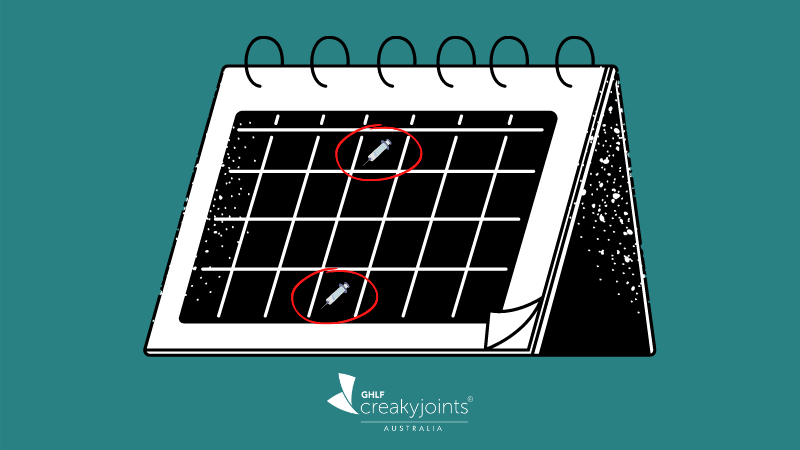

The COVID-19 Vaccine National Rollout Strategy
On 7 January 2021, the Australian Prime Minister, Scott Morrison, gave a press conference announcing the COVID-19 Vaccine National Rollout Strategy. He was joined by the Federal Minister for Health, Greg Hunt, the Secretary of the Department of Health, Professor Brendan Murphy and Australia’s Chief Medical Officer, Professor Paul Kelly.
(Read a complete transcript of this press conference on the Prime Minister of Australia website.)
During the press conference, the Prime Minister and his colleagues announced that the rollout is now expected to start in mid-February. That’s a month earlier than previously anticipated. Minister Hunt stated that the initial timeline allowed for delays in receiving data, planning, testing and so on. The data from Pfizer will be available soon and the TGA have advised that they can assess that data as soon as possible. Other parts of the planning process are also on schedule so the timeline can be brought forward.
Prime Minister Morrison also stressed that “Australians want a swiftly developed and administered vaccine. But more importantly, they want a safe one, and they don’t want corners cut on that process … The Australian way is to follow the processes … but I do put this very strong qualification. The data has to match up and the data has to meet the requirements of the TGA”.
All vaccines will be free (including the appointment to get the vaccination). Also, all vaccinations and doses will be recorded via the Australian Immunisation Register.
Each vaccination site will only be used for one type of vaccination and people must use the same site for their first and second doses. This will help avoid confusion as to who has received what vaccine.
COVID-19 Vaccine Distribution Phases
Once approved by the TGA, Australia’s COVID-19 vaccines will be distributed in five phases (Phase 1a, Phase 1b, Phase 2a, Phase 2b and Phase 3) based on priority groups with some detail given for the initial phases.
Phase 1a will start as soon as the first vaccine passes the full TGA approval process. This will likely be the Pfizer vaccine and it can only be ordered once approval has been granted and it will still need to undergo batch testing when it arrives here. It is currently estimated to be available for distribution to 30 to 50 designated Pfizer hubs in urban and rural Australia by mid-February. These hubs will serve both as vaccination sites and as bases for outreach teams to go into aged-care facilities and disability residences to vaccinate residents in those places.
The people to receive the vaccine in this phase will be those that “provide the most necessary ring of containment and protection for the Australian population”. They include:
- Quarantine and border workers
- Frontline health officials
- Those working in aged care and disability care
- Residents of aged care and disability care
Phase 1b will possibly coincide with the availability of the Oxford AZ vaccine several weeks after the initial rollout of Phase 1a. It may overlap with the distribution of the second dose of the Pfizer vaccine for the recipients in Phase 1a.
A large number of vaccinations will be added in time for the rollout of Phase 1b. These sites will include existing Commonwealth GP respiration clinics, some state-run vaccination clinics and Aboriginal-controlled community health services, some general practice clinics and (potentially) some pharmacies.
Recipients in this phase will include people who are at increased risk of developing severe COVID disease. These include:
- People over 70 years
- Other healthcare workers
- Aboriginal and Torres Strait Islander people over 55 years
- Critical and high-risk workers including defence, police, fire and emergency services as well as those working in meat processing
- Younger adults with a medical condition, including those with a disability (no further details given at this stage)
Phase 2 will begin as soon as practicable after the initiation of Phase 1 and may overlap with it. Recipients will most likely receive the Oxford AZ vaccine, at least in the first few months. If the Moderna vaccine gets approved later in the year, that will also be included in the rollout.
Phase 2a recipients will include:
- Adults aged 50 to 69 years
- Aboriginal and Torres Strait Islander people aged 18 to 54 years
- Other critical and high-risk workers
Phase 2b will include the balance of the adult population.
Phase 3 will include those under 18 (if recommended).
Although this national vaccination program presents a major logistic exercise, our Government believes our country is up to the challenge. Our vaccine distribution mechanisms (including the supply of syringes, PPE and other resources) are also well underway. The distribution process will be aided by the pharmaceutical companies behind the approved vaccines as part of their agreement with the government.
Watch This Space
CreakyJoints Australia will be closely watching developments in this area and will share more information relevant to our readers throughout the coming months. For updates, subscribe to our newsletter (using the Login or Register button at the top of this page) or follow us on Instagram or Facebook. (Note that we share our Facebook feed with our sister organisation, CreakyJoints US.)
* When following the link to the content on the CreakyJoints US website you will be directed away from this CreakyJoints Australia site. Some of the information shared on the CreakyJoints US site will not be relevant to people in Australia so remember to check back with us for local information.
This information should never replace the information and advice from your treating doctors. It is meant to inform the discussion that you have with healthcare professionals, as well as others who play a role in your care and well-being.
The original version of this article was reviewed by Sydney rheumatologist Dr Irwin Lim from BJC Health. This updated version includes more information on the Australian COVID vaccination rollout and some information provided by our sister organisation, CreakyJoints US.
Keep Reading
- Living With Arthritis During COVID-19: Education and Support Resources
- Australian Patients Speak Up to Help Shape Healthcare During COVID-19
- CreakyJoints Australia Supports the #DontWaitMate COVID-19 Healthcare Campaign
- Arthritis Treatments
- Patient Stories
See the CreakyJoints Australia Raising the Voice of Patients series for general information about medications, clinical trials, vaccines and infection risks for people with specific autoimmune conditions.

